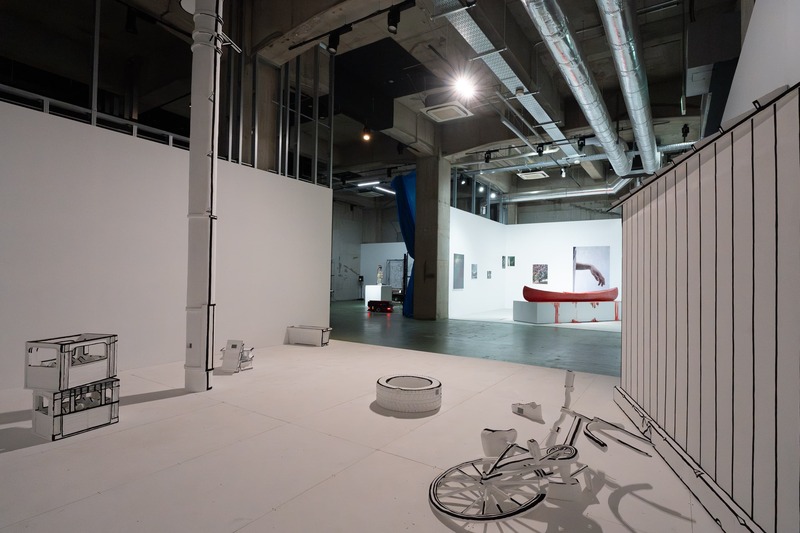(Image above)Exhibition View of TERRADA ART AWARD 2023 Finalist Exhibition / Photo by Yusuke Suzuki (USKfoto)
As contemporary Japanese artists make their mark worldwide, attention is now focused on identifying the artists who will shape the next generation of the art scene. Warehouse TERRADA has been engaged in the art storage business since the 1970s and actively supports young artists making a mark on the global stage. The innovative creations of the five finalists, showcased in a renovated warehouse space, radiate artistic brilliance. Admission to this exhibition is free, attracting numerous art collectors and enthusiasts eager to stay ahead in discovering the ‘next’ in the art world.
TERRADA ART AWARD is one of Asia’s most notable contemporary art awards and aims to support emerging artists. To discover artists who can play an active role on the world stage, we have conducted this award with the jury panel, with an international perspective and a deep understanding of contemporary art. This year, the award received 1,025 entries from Japan and overseas, and Mitsuo Kim, Yuma Tomiyasu, Yuki Harada, Satoshi Murakami, and yang02 were selected as finalists. Visitors can observe how the finalists perceive and predict the direction of the unsettled world situation, even though the pandemic has been contained. The spatial composition and architectural perspective, the comparison and application of digital/analog devices, the information and stories that materials hold, and each entire space itself is their artwork.
Each finalist received prize money of 3,000,000 yen to accommodate the production of the actual artworks and an opportunity to exhibit the works at one of our facilities.
On the exhibition’s opening day, each finalist was awarded by the final jury: Takahiro Kaneshima, Yukie Kamiya, Yuki Terase, Daito Manabe, and Meruro Washida.

Finalists (From left: Mitsuo Kim, Yuma Tomiyasu, Yuki Harada, Satoshi Murakami, and yang02)
[About Five Finalists and their exhibits]
Mitsuo Kim
On a metal display stand equipped with a heat source, I will exhibit an installation of a red canoe made of wax that slowly melts and collapses over time, along with two-dimensional works also made of wax. Since last year, I have been seeing a lot of news about the war in Ukraine. Seeing images of fathers going to the war and their wives and children fleeing the country reminded me of the stories of my mother and grandparents. This is not a story which I am unfamiliar with. This time, the melting red canoe is not only a sinking canoe, a parting, or an ideological divide, but also a departure for a new world, and a hope for peace and tranquility. It will be an exhibition that shows what continues while encompassing fragility and contradiction.

Artwork by Mitsuo Kim, Photo by Yusuke Suzuki (USKfoto)
Born in Osaka in 1987. He received an M.A. in Fine Art from the Graduate School of Arts at Kyoto City University of Arts in 2012 and Kyoto City New Artist Award 2016. His solo exhibitions include “Blue Summer” (Der-Horng Art Gallery, 2022), “Goodbye My Love” (LEESAYA, 2021), “White light White heat” (21st Century Museum of Contemporary Art, Kanazawa, 2014) and group exhibitions include “Positionalities” (@KCUA, 2022), and “PATinKyoto2016” (The Museum of Kyoto, 2016).
Yuma Tomiyasu
I have been interested in the shift in perspective, such as switching between one’s own perspective and that of others. It could be a transcendent being’s viewpoint, or it could be a ghost’s one. Or it may be the multiple overlapping gazes of the self that transcend dimensions. The viewpoint of dreaming is not captured by the eyes, but we recognize that we indeed see it. Such shifting between multiple perspectives induces a strange sensation of going back and forth between dimensions and makes us aware of the instability of its foundation.
The structure of a magic mirror means that when it is not visible from one side, it is visible from the other side. The monitoring camera in the room set in this installation should also show the viewers outside the room, but it will not show the viewers at a time when they can see the monitor. In this work, the programming of the lighting forces the visible objects to shift, thereby shaking up the concept of seeing and being seen.

Artwork by Yuma Tomiyasu, Photo by Yusuke Suzuki (USKfoto)
Born in Hiroshima in 1983. After undergraduate and master’s studies at Chelsea College of Arts, University of the Arts London, she received her Ph.D. in Fine Art from Tokyo University of the Arts in 2017. She creates immersive installations and paintings that evoke in the viewer a perception of the invisible and uncertain. Selected exhibitions include “TOMIYASU Yuma: In Presence of Shadows” (Maruki Gallery For The Hiroshima Panels, 2023), “Setouchi Triennale 2022” (Kagawa, 2022), “Aperto 15 TOMIYASU Yuma The Pale Horse” (21st Century Museum of Contemporary Art, Kanazawa, 2021-22), “KAAT EXHIBITION 2020 Yuma Tomiyasu | Shadows of Wandering” (KAAT Kanagawa Arts Theater , 2021). Selected Awards include a special prize of “The 21st Taro Okamoto Award for Contemporary Art” (2018), shortlisted for “The 12th shiseido art egg” (2018).
Yuki Harada
“I myself don’t go anywhere. I myself am always there, waiting for me to return, like a shadow.” These lines are part of the script in this work. Emigrants who journeyed to Hawaii from Japan helped to create a transnational culture symbolized by Hawaiian Pidgin through their interaction with other cultures and languages. The work re-enacts the process they presumably experienced. This re-enactment is based on the layering of voices through “shadowing” of the sort used in language learning and the layering of emotions by tracking my facial expressions on digital humans. The farther we go, the more we end up returning to ourselves—this is human nature. That we feel we must go forward anyway is human instinct. I want to express this distorted, powerful movement in the entire space.

Artwork by Yuki Harada, Photo by Katsura Muramatsu
Born in Yamaguchi in 1989. He creates art works based on the motif of visual culture, which is widely recognized in society, despite its insignificance. Since 2019, he has stayed in Hawaii on several occasions and has focused on transnational cultural motifs represented by “Pidgin English”. In recent years, Harada has held solo exhibitions “Go stay go Pakiki all da time! Eh… no give up ‘til you pau!” (Museum of Japanese Emigration to Hawaii, 2023), “Unreal Ecology” (Kyoto Art Center, 2022), “Waiting for” (21st Century Museum of Contemporary Art, Kanazawa, 2021). His main publications are “Christian Lassen: A critical biography” (Chuokoron-Shinsha, 2023) and “Insignificant Arts” (Kenele Books, 2023).
Satoshi Murakami
“I’m just a stage prop. I don’t have any lines or anything.”
I dreamed that was talking to me on the stage. She was put on stage without being told what was going on, had no idea what she was supposed to do, and seemed to be in trouble. I felt that there was a kind of universal form of that permeated from the era of the industrial revolution to the present day.
Around the same time, I knew that my grandfather, who was suffering from dementia, thought the coat hangers in the hallway was a person. I thought about the possibility that it was not really a coat hanger, but something else, and that only a person who has grown old and become a “cognitive general” would be able to recognize its existence. When giving form to these experiences as an artwork, I had an epiphany that I might also be able to consider the issue of “outline” in drawing at the same time. By extension, it may be possible to overcome the binary opposition between fiction and non-fiction, memory and fabrication.

Artwork by Satoshi Murakami, Photo by Yusuke Suzuki (USKfoto)
Born in Tokyo in 1988. Graduated from the Department of Architecture, Musashino Art University in 2011. Running some projects such as living in a self-made Styrofoam house “Living Migration”, and living in a billboard using advertising income “Billboard House”. Major solo exhibitions include “Living Migration” (21st Century Museum of Contemporary Art, Kanazawa, 2020), and major group exhibitions include “Takamatsu Contemporary Art Annual vol.08” (Takamatsu City Museum of Art, 2019). Major publications include “Days with my small mobile house” (Seki Shobo).
yang02
The future is perhaps distant, but surprisingly near. There was a rumor going around that there were actual pieces of “ART” left somewhere that people had long since forgotten how to make with their own hands or see in person. One day, several curious apparatuses discover some “ART” wrapped in blue sheets in a back part of a warehouse. But even looking at the “ART,” they could not understand the “ART”. What value could these things possibly have? At least, it seemed impossible to explain with the languages or the logics of the people of this time period. Therefore, they began to try to understand the “ART” by imitating human behaviors related to the “ART” in the past, such as drawing, installing, and seeing them.

Artwork by yang02, Photo by Yusuke Suzuki (USKfoto)
Born in Kanagawa in 1984. yang02 graduated with a master’s degree in Information Design (Media Art) from Tama Art University in 2009. His works SENSELESS DRAWING BOT and Avatars, both created in collaboration with So Kanno, were awarded, respectively, the New Face Award at the 15th Japan Media Arts Festival in 2012 and the Excellence Award at the 21st Japan Media Arts Festival in 2018. Recent group exhibitions include “Roppongi Crossing 2022: Coming & Going” (Mori Art Museum, 2022), “Someone Far Away” (Sapporo Cultural Arts Community Center, 2021), “20th DOMANI: The Art of Tomorrow” (The National Art Center, 2018), and “Aichi Triennale” (Aichi Prefectural Museum of Art, 2016).
[Exhibition Overview]
Title: TERRADA ART AWARD 2023 Finalist Exhibition
Dates: January 10th (Wed) – January 28th (Sun), 2024
* Open everyday
Venue: Warehouse TERRADA G3-6F (2-6-10 Higashi-Shinagawa, Shinagawa-ku, Tokyo 140-0002)
Open hours: 11:00 AM – 6:00 PM (Last admission at 5:30 PM)
Entry fee: Free * No reservation required
URL: https://www.terradaartaward.com/en/finalist/
[TERRADA ART AWARD 2023 Overview] https://www.terradaartaward.com/en
Name: TERRADA ART AWARD 2023
Qualifying Activity: Contemporary Art (including all forms of media such as two-dimensional works like paintings; photography; three-dimensional works (objects); textiles; videos; digital media art; physical expression such as performances, etc.; and sound art or music, etc.)
Prize: 3 million yen awarded to each of five finalists
* Includes fees paid to display the works of finalists at the Finalist Exhibition, as well as fees for creating and displaying new works
Supplementary Prize: Ruinart Blanc de Blancs, PIGMENT TOKYO products worth 100,000 yen, and free use of Warehouse TERRADA’s art storage services for 2 years
Held by: Warehouse TERRADA
Sponsor: Japan Airlines, MHD Moët Hennessy Diageo K.K.
Operation Support: Fujiwara Haneda LLC

Grant: Supported by Arts Council Tokyo, Tokyo Metropolitan Foundation for History and Culture
[TERRADA ART AWARD 2023 Jury] (in Japanese alphabetical order)
Final Jury: Takahiro Kaneshima (Associate professor of Kanazawa College of Art), Yukie Kamiya (Art Critic, Independent Curator), Yuki Terase (Art Intelligence Global Founding Partner), Daito Manabe (Founder of Rhizomatiks, artist, interaction designer, programmer, and DJ), and Meruro Washida (Director of Towada Art Center, Associate professor of Tokyo University of the Arts)
Primary Selection Jury: Ryo Ikeshiro (Artist, musician, researcher, Assistant Professor, School of Creative Media, City University of Hong Kong), Shinji Ohmaki (Artist), Eriko Kimura (Deputy Director and Chief Curator, Hirosaki Museum of Contemporary Art), Ryutaro Takahashi (Psychiatrist, Art Collector), Yuu Takehisa (Curator, Artistic Director of Contemporary Art Center, Art Tower Mito), and Reiko Tsubaki (Curator, the Mori Art Museum)
Jurys’ overall assessment: https://www.terradaartaward.com/en/finalist/
Jury’s profile: https://www.terradaartaward.com/en/member/
[About Warehouse TERRADA]
Established in 1950 and located in Tennoz, Tokyo, Warehouse TERRADA has since expanded into a wide range of fields, with a primary focus on the storage of artworks, which launched in 1975, as well as artwork restoration, transportation, and exhibitions. In 2014, we began operating a bonded warehouse for artworks. We established a new bonded warehouse in the spring of 2022, which we opened as a permanent bonded gallery venue that allows for viewings, storage and more under bonded conditions. We offer foreign and domestic art collectors opportunities to purchase artworks and give overseas galleries a chance to expand their presence in Japan. We also operate art studios that are available for rent as well as hosting the ART AWARD, supporting younger artists. These initiatives earned us the Montblanc de la Culture Arts Patronage Award in 2018. In recent years, Warehouse TERRADA has opened several facilities that promote art and culture, including the collectors’ museum of contemporary art “WHAT MUSEUM”, art gallery cafe “WHAT CAFE”, art materials lab “PIGMENT TOKYO” and TERRADA ART COMPLEX, one of Japan’s largest gallery complexes. Through these broad-ranging art industry operations, and as a leading company in the Japanese art world, we provide services that will play a role in revitalizing its art market and develop Tennoz, Tokyo, as a hub of art together with other cities around the world.
Company name: Warehouse TERRADA
Representative: President & CEO, Kohei Terada
Address: 2-6-10 Higashi-Shinagawa, Shinagawa-ku, Tokyo
Foundation: October 1950
URL: https://www.terrada.co.jp/en
[Award Inquiry] TERRADA ART AWARD Office E-MAIL award@terrada.co.jp




